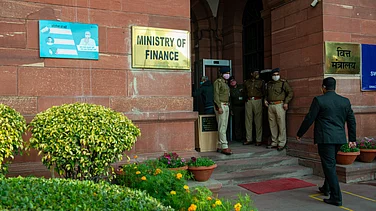To restore institutional trust among investors in the private sector, the new Modi 3.0 government must ensure that policies are stable and thoroughly considered before being announced, according to Aradhna Aggarwal, a senior advisor with the National Council of Applied Economic Research (NCAER).
In an interview with Outlook Business, the economist said that investors in India have lost faith in government policies, which is evident in the decline of private investment in the country. "People lose trust not only because they doubt the longevity of policies but also due to weak implementation," she says.
Aggarwal, a noted Special Economic Zones (SEZ) economist, discusses in her book Special Economic Zones in South Asia how the failure of SEZ policy has hindered India's ambition to become a manufacturing hub, among other global and domestic issues.
Edited Excerpts:
In one of your chapters focusing on India, you say the SEZ policy drifted to failure around 2014. How much did it impact economic growth?
The decline of SEZ performance began as early as 2012, primarily due to the withdrawal of significant tax incentives. These measures had a substantial impact, causing investor interest to wane. Over time, further tax incentives for developers and companies within SEZs were also withdrawn, a move that was not initially planned or stipulated by the SEZ law, which was supposed to be the overriding regulation.
This unpredictability in policy caused a loss of confidence among investors. Consequently, the momentum that SEZs had in generating manufacturing employment, increasing incomes, and attracting foreign direct investment slowed down significantly.
So, does it mean that initiatives like “Make in India” or the PLI scheme would have had greater benefits if this had not been the case?
Indeed, if we had integrated SEZs with the "Make in India" initiative and actively promoted it through these zones, it could have been a powerful strategy. Unfortunately, the potential of SEZs was not fully recognized or utilized, which significantly impacted the overall process. It wasn't just about domestic investment—foreign investors, who were initially looking at India and SEZs as promising opportunities, received mixed signals.
Do you think East India should have received more SEZs, given the significant economic disparity that is evident today?
In India, one of the positive aspects of SEZs was the emphasis on private ownership. These zones were primarily developed by private individuals and companies, with state governments participating only on a limited scale. Most of the SEZs were driven by private sector initiatives, and the location of these zones was determined by the economics of location rather than government mandates. Private investors carefully assessed where to establish these zones, selecting locations that best suited their business needs. As a result, we saw SEZs flourish in industrialised coastal states in the South, as well as in the West, particularly in Gujarat and Maharashtra.
So, naturally, there was a preference for investors to choose these industrialised regions over states like West Bengal. West Bengal, in particular, experienced significant de-industrialisation starting in the 1970s. This decline in industrial activity made it less attractive for investors compared to more industrialised states.
How important social and cultural aspects are in the success of SEZs? What unique challenges or advantages you identify for India in this regard?
In India, we have deeply ingrained social and cultural aspects that are closely tied to the overall development process. My perspective on SEZs is that they have the potential to mitigate some of the negative impacts these socio-cultural factors can have on growth. By operating within the SEZ framework, we can potentially overcome certain obstacles to development that arise from these socio-cultural influences, which otherwise might have an adverse effect on economic growth.
For instance, research has shown that countries with Protestant populations have developed more rapidly compared to those with Orthodox Christian populations. This is often attributed to the more liberal attitudes associated with Protestantism. Similarly, the difference in economic development between the United States and Europe can be linked to socio-cultural factors. The U.S., with its more liberal and progressive mindset, contrasts with Europe's more conservative approach, which can hinder rapid economic progress.
When you say 60% of the SEZs have focused on the IT sector alone, does it mean there has not been a clear vision to promote broad-based manufacturing?
When we launched the SEZ policy, we did so without a clear vision document or a strategic framework. The primary motivation was to position India as a manufacturing hub similar to China. At that time, there was significant expectation from policymakers that SEZs would transform India into a major manufacturing centre.
During my interviews with policymakers from that period, I learned that the inclusion of the IT sector in the SEZ scheme was a strategic decision. The intention was to demonstrate the policy's effectiveness quickly. Unlike manufacturing SEZs, which take time to develop and require significant infrastructure, IT SEZs could start operations more rapidly.
As protests over land acquisition and other issues emerged, policymakers began withdrawing benefits. This policy shift disproportionately affected manufacturing SEZs. Consequently, manufacturing SEZs were further sidelined, and the policy's benefits became concentrated on the IT sector alone.
You conclude at the end of the chapter, that the decline in private fixed capital formation as a percentage of GDP can be attributed to the loss of investor’s trust in government policies. How can the new government revive this trust?
In my view, a significant issue in India is the lack of institutional trust. People generally do not trust the government. Often, policies are announced hastily without thorough consideration, leading to initial enthusiasm followed by withdrawal due to unforeseen issues or public backlash.
It’s crucial to approach policy-making with prudence, ensuring that policies are stable and well-considered before announcement. People lose trust not only because they doubt the longevity of policies but also due to weak implementation. Addressing these issues—by maintaining policy stability and strengthening implementation—can help rebuild trust and ensure more effective governance.



























